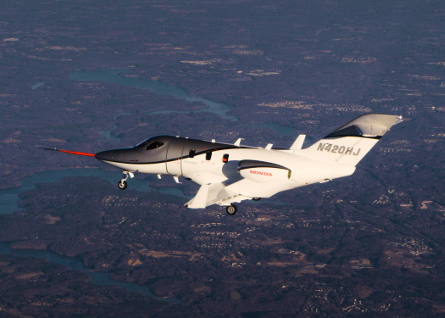Test pilots on board the first conforming HondaJet entry-level business jet reported "brisk acceleration" and a climb rate "like a rocket" for the twinjet, says Honda Aircraft president and chief executive Michimasa Fujino.
The company kicked off the informal start of its Federal Aviation Administration certification bid on 20 December with a 51min flight of the aircraft, one of five conforming models to take part in the certification programme aimed at third-quarter 2012 service entry for the type.
Compared with the proof-of-concept aircraft, the conforming HondaJet has 1,950lb take-off thrust (8.7kN) for each of its two GE-Honda HF120 turbofan engines, up from 1,700lb each for the proof of concept aircraft.
 |
|---|
© Honda |
Fujino says the new aircraft is similar to the proof of concept externally, with the exception of a fuselage extension of "a few" centimetres to add more cabin volume. The empennage is also a few centimetres longer and the vertical stabiliser a few centimetres higher as part of a drag "clean up", adds Fujino.
"From now, we'll expand the envelope and conduct systems testing," says Fujino, adding that the "phased approach" to detailed flight testing will begin in 2011, with 30-40 people dedicated to the test programme.
He says Honda is planning to add two more aircraft to the test programme in the next 12 months. Planned total certification flight time will be at least 1,500 flight hours using five aircraft, three for flight-testing and two for structural testing. Honda has flown its proof of concept aircraft for more than 500 flight hours.
Fujino says data from first flight including short period pitch damping, Dutch roll damping and directional stability are "all very close to estimates" and were slightly improved compared with the proof-of-concept HondaJet.
The aircraft uses traditional human-powered controls activated by cables. Pilots also reported that the HondaJet's Garmin G3000 integrated avionics suite, with touchscreen controllers, made it "truly a single-pilot" aircraft.
"It's very easy to use and remember," says Fujino. "Current pilots spend most of their time remembering the functionality [of the flight management system]," he says. "With the G3000, I don't have to do that. I can use it like an iPod."
Fujino says aircraft number five will be the first to have a production interior, which will be installed at the company's 24,720m2 (266,000ft2) production facility in Greensboro, North Carolina.
Flight into known icing certification will come later in 2012, says Fujino, although the company has prepared for the process through "many" windtunnel icing tests using augmented aerofoil shapes developed with computational fluid dynamics programmes.
The aircraft will use bleed air from the HF120s for the wing leading edge and engine inlet anti-icing and an electro-mechanical expulsion de-icing system built by Cox and Company for the empennage.
Fujino says he expects to build 30 aircraft in the first six months of production to meet demand, and will ramp up further in 2013. Honda reports more than 100 orders for the $4.5 million aircraft.
Fujino says customers will be expected to make a milestone payment on their orders now that first flight has been accomplished. He has not revealed the amount of the payment.
Source: Flight International



















